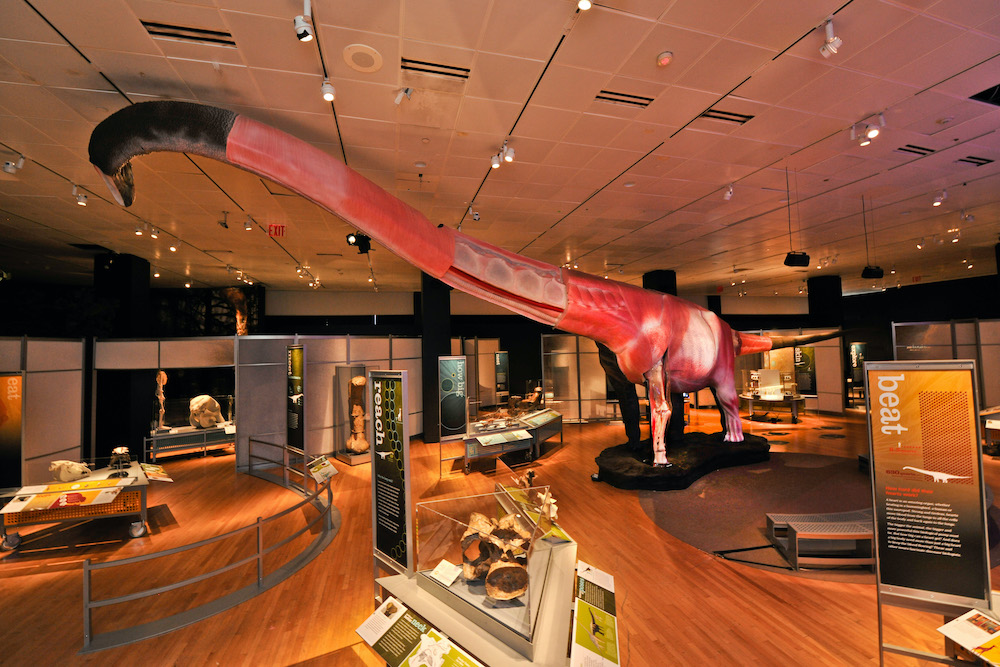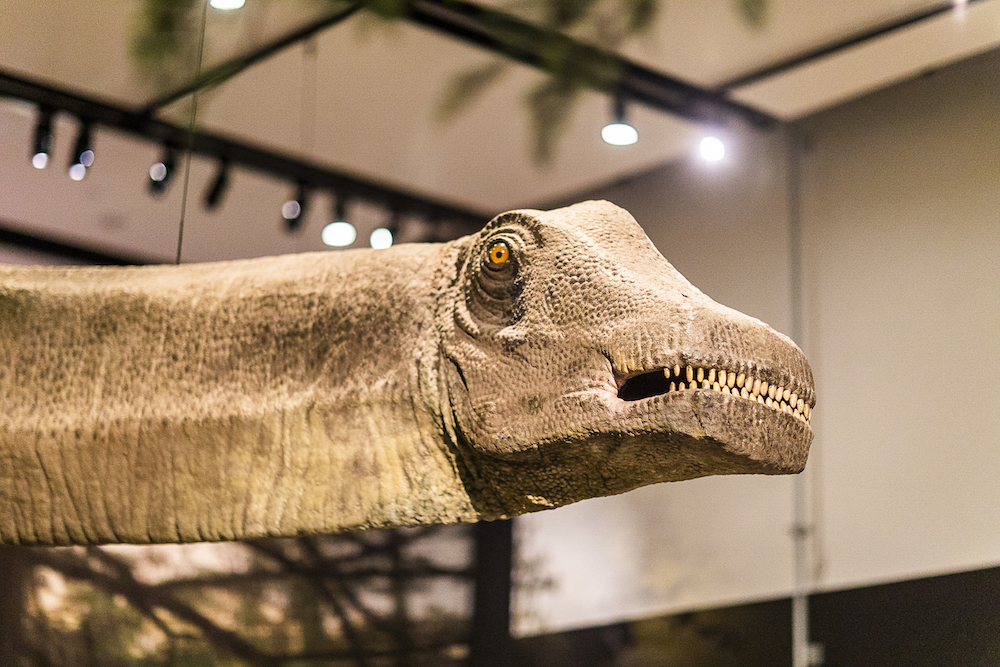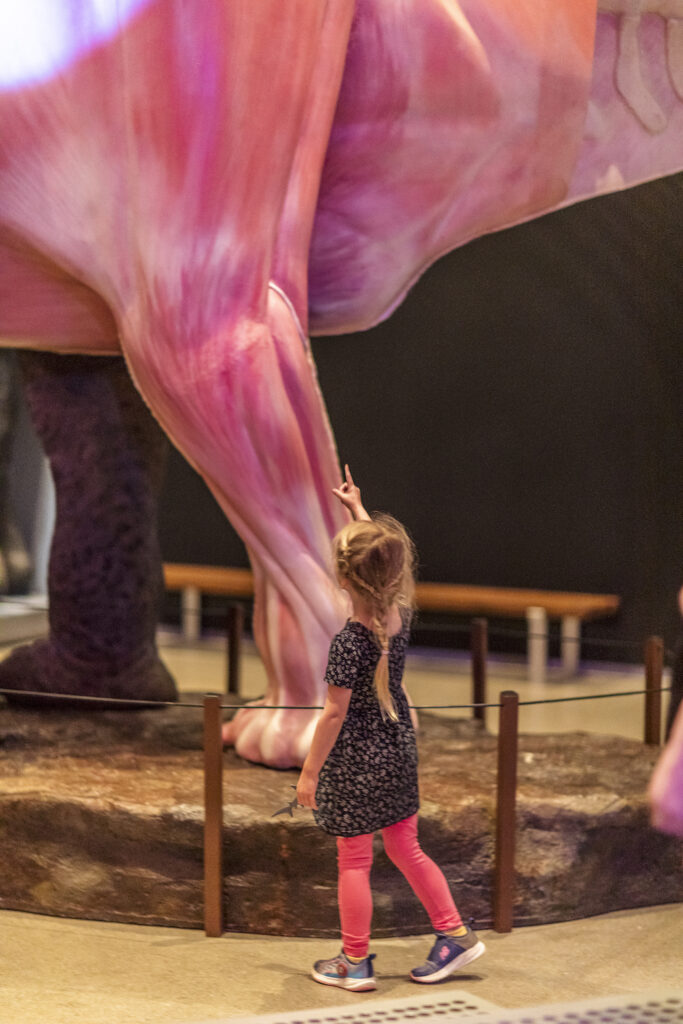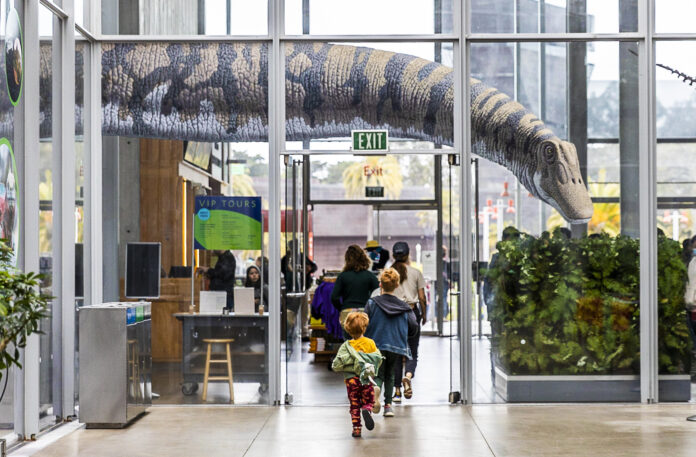Get ready for big—make that categorically colossal—numbers. Prepare to feel small—make that totally tiny—by comparison.
The California Academy of Sciences new exhibit “The World’s Largest Dinosaurs” (runs through January 21, 2024) promises to wow visitors with facts, figures, and phenomenal replicas of long-necked sauropods. From the moment one enters and is confronted by the head of an Argentinosaurus, a sauropod estimated to have been up to 140 feet long and weighing up to 90 tons, the expo’s numbers game launches—then skyrockets. There is an 18-year-old, 60-foot-long teenaged female Mamenchisaurus, whose long neck is a marvel of innovative respiratory engineering. Nearby, a 15-foot-tall replica of the hind leg of a Supersaurus dwarfs the touchable display’s comparative elements such as replica legs of a hummingbird, African elephant, and human.

Gradually, the exhibit reveals the masterful biology and science behind sauropods, including what they ate and how they digested the copious amounts of plant food needed to supply their daily requirement of 100,000 calories. Other questions answered include, how did gigantic sauropod mothers and fathers incubate—but not squash—the eggs smaller than soccer balls while they were developing in the nest? What miracles had the baby sauropods emerge as hatchlings weighing only 11 pounds and mature (in three decades) into adults weighing up to 55 tons?
We learn an adult Mamenchisaurus’ heart pumped 630 quarts of blood to its enormous structure—human hearts pump just 6.5 quarts—and its respiratory system inhaled about 174 pints of air with each breath, compared to a human inhalation of one pint per breath. In a nearly 6-foot tall plexiglass cube, the contents—1,000 pounds of plant matter representing roughly a day’s worth of food for a Mamenchisaurus—seems unfathomable, indigestible. One counterpoint, a we-are-bigger comparative measure, manages to be even more stupendous than all the other enormity. Despite sauropods’ large heads, the largest Apatosaurus brain weighed a mere four ounces, compared to the 48-ounce human brain.
Organized by the American Museum of Natural History in New York, the exhibit is curated by the museum’s division of paleontology curator emeritus Mark Novell, with guest co-curator Martin Sander from the University of Bonn in Germany. Designed as a highly interactive experience, the exhibit includes several hands-on opportunities to answer for yourself the intriguing questions about how these supersized animals grew, lived, and thrived for roughly 140 million years. The displays draw repeated connections and correlations to modern relatives of dinosaurs, such as birds and crocodiles. Comparisons of sauropod anatomy to the human body renders one message most explicit and completely: these dinosaurs are some big-time animals.

“They’re the largest animal that ever walked on earth,” says the Academy’s executive director Scott Sampson. “People think the blue whale is the biggest, but the blue whale cheats because it lives in water.” Sampson is a paleontologist and well-known by the younger set as Dr. Scott on the PBS children’s show “Dinosaur Train.”
He’s not afraid to be disruptive, saying, “And dinosaurs are not extinct. Today, we just call them birds.”
Birds, Sampson emphasizes, are descendant from theropods, a group of dinosaurs that includes the Tryannosaurus rex and other velociraptors (most of which were actually much smaller than those depicted in the movie Jurassic Park.) “If you want to look at and study dinosaurs without having to go to university for years like I did, just step out the back door or go out on the street. When that asteroid crashed into the earth and destroyed all of the big dinosaurs, the birds survived.”
Sampson says he’s been a dinosaur paleontologist since the age of four, and could spell “paleontology” correctly long before his own last name. “In terms of books about dinosaurs, I devoured them, and the most powerful was Prehistoric Animals by Joseph Augusta. It wasn’t the words; it was the illustrations by Zdeněk Burian. They ignited my imagination.”
Many of those illustrations and the science they were based on turned out to be incorrect, but that just triggered Sampson’s desire to learn more. As he gained knowledge, his young mind filled with questions: How did an enormous sauropod have a skull the same size as a horse skull and still manage to eat enough food to survive? What were the benefits of that long, long neck?
Spoiler alert: “It used its teeth to rip off vegetation and all the processing happened in the gut,” he says. “Food would be in there for days and potentially longer than a week while it digested. And breathing? Every time you or I inhale, it’s about a pint of air, but for a Mamenchisaurus we estimate its 175 pints. That’s a huge amount of air to pump up to the head 30 feet away so there’s engineering built into the skeleton. The bones of the neck are actually filled with air sacs. That both lightens the neck so they can lift their heads up but also is part of the breathing and cooling system. And sauropods could stand in one place, burn less calories, and reach food 30 feet away or 30 feet above them.”
He says he does not get frustrated about all that paleontologists still don’t know about dinosaurs. “I find it exciting. Future paleontologists might be answering questions that we don’t even know to ask. We have 46 million specimens at the academy and people ask why we keep so much stuff. I tell them we keep it so that we can answer new questions later as new technologies develop.”

Supersize dinosaurs allow people to experience a kind of splendid awe Sampson believes is, “the only emotion that takes us outside ourselves to experience the larger world and the universe and give us a feeling we belong to it.” While gazing at replicas of these animals the length of four city buses that walked on the planet, he says it’s important to recognize that if dinosaurs hadn’t lived, we wouldn’t be here.
“The world has continuously evolved during the billions of years (from Earth’s formation) to now,” says Sampson. “Flowering plants we see today evolved during the Cretaceous time period, the last major time period during which dinosaurs lived. They evolved in response to being not eaten or eaten and their seeds spread by dinosaurs.”
One thing to remember after experiencing the exhibit is that humans are part of a grand story that has been unfolding for billions of years.
“We need to see ourselves as players in this drama,” says Sampson. “The final scenes are not yet written. It’s a most pivotal moment. We have about a decade to put ourselves on a more regenerative path. We can’t solve all of Earth’s problems in 10 years, but we can’t wait to begin. We have to see ourselves not outside of nature, but deeply embedded in it. Then we will move in a positive direction.”
THE WORLD’S LARGEST DINOSAURS runs through January 21, 2024. California Academy of Sciences, SF. Tickets and more info here.





